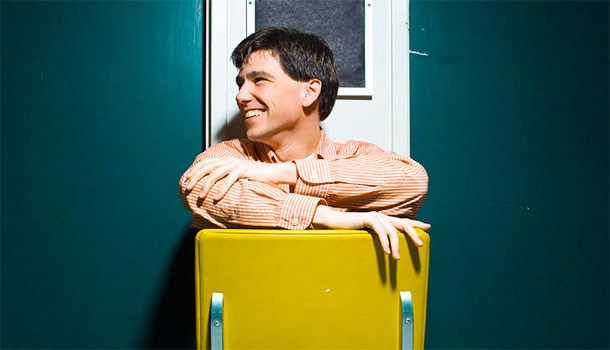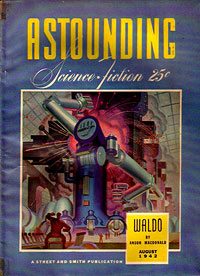
From pantographs to nanosoldiers
Wednesday 6 July 2011
Colin Milburn of UC Davis has investigated how the early history of nanotechnology was influenced by ideas from science fiction. He also studies how scientists use video game hardware and software to run experiments.
When a scientist comes up with a game-changing insight, is there a Eureka moment — a single synaptic flash when it all makes sense?
Science lore envisions the genius researcher poring over puzzling new data when suddenly everything comes together — the dawn of a new way of seeing the world. Sometimes though, scientific revelations come almost directly from ideas already floating about in popular culture.
How cultural influences such as science fiction affect modern research and how, in turn, science shapes the way we see the world, has long intrigued UC Davis science historian and literary theorist Colin Milburn.
He startled colleagues — and himself — 10 years ago when he showed that one very recent technological revolution had its origins in the pages of science fiction.
The late Richard Feynman, a brilliant Caltech physicist and Nobel laureate, has been called the father of nanotechnology for a visionary speech he made in 1959 proposing the fabrication of nano-scale materials and machines, essentially by putting atoms where we want them.

The influential speech was called “There’s Plenty of Room at the Bottom.” It seemed futuristic — visionary, even — but it was not entirely novel, Milburn has shown. The basic concept of manipulating infinitesimal materials can be traced to a short novel called "Waldo," written almost 20 years earlier by science fiction writer Robert Heinlein.
“The specific mechanism Feynman proposed in 1959 comes directly — not verbatim, but close — from 'Waldo,'” said Milburn. “In his speech, Feynman suggested techniques that Heinlein had depicted for manipulating materials at a sub-micron scale.”
Heinlein called his imagined nanomanipulator system the “Waldo F. Jones Synchronous Reduplicating Pantograph,” where a tiny machine he called “hands” would create tinier hands operating at smaller and smaller scales, eventually intended to work within the space between neurons. Feynman’s talk also envisioned a self-duplicating “pantograph,” where tiny machine “hands” would create tinier hands, eventually intended to work on individual atoms, Milburn said.
As it turns out, a colleague of Feynman’s had become quite enamored of the whole Waldo idea, and had described it to Feynman in the months before the now-famous Caltech talk.
The cultural influences on Feynman’s revolutionary idea extend beyond "Waldo," Milburn points out. Heinlein, in a sense, adapted some of his ideas from a story written 10 years earlier by Edmond Hamilton, called “The Cosmic Pantograph.” And science fiction as early as the 1920s depicted technologies for atomic- and molecular-level engineering — works that constitute what Milburn calls the “prehistory” of nanotechnology.
Once you look for them, such influences abound. Many scientists in nanotechnology and molecular biology now use video game hardware and software to run experiments, and a number of them have developed experiments as a kind of game play. For example, the wildly successful Foldit game uses crowd-sourcing and video game methods to study protein biochemistry. The reverse, of course, is also true. Computer gaming is rife with narratives involving molecular scientists, said Milburn, who also is a member of the UC Davis Department of English, Science and Technology Studies Program and the Humanities Innovation Lab.

"Over the last 10 years, I have easily played more than 100 different Japanese, European, and American video games with nano themes,” said Milburn. “One game I’m particularly keen on is Crysis: The Korean military finds an alien artifact in a South Sea Island, and the U.S. covertly sends in a crack military unit armed with ‘nanosuits’ that give these soldiers superhuman capabilities. The design of the suits was inspired directly from prototypes developed by the US Army-sponsored MIT Institute for Soldier Nanotechnologies."
So, even as popular culture spawns scientific innovation, the products and enterprise of science and engineering shape culture. Milburn calls this “mutual modification.”
In an age of exploding oil rigs and nuclear power plants, breached levees and sporadic qualms about biotech advances, the enterprise of science no longer holds the popular culture entirely in its thrall — if it ever did. Milburn is concerned about what he considers overdue scrutiny of nanotechnology’s environmental implications.
“There is now a growing group of researchers rigorously investigating potential environmental effects, but at the outset of this new technology, there was a terrific twist toward its economic potential, without paying much credence to possibilities of long-term environmental risk.”
Milburn is concerned about the hype surrounding “green nanotechnology,” which he suspects is often less green than we would like to believe. “One could argue that the industrial demands for new products — or re-inventing old products — using nanotechnology will not quickly solve environmental problems, and in fact might eventually cause greater ones.”
But he is generally enthusiastic about the promises of new technologies. In the long run, he says, many technological advances are going to be beneficial to our health, environment and economy. Even the exuberant promotion of new technologies by scientists, industry and political leaders actually drive scientific progress, he thinks.
We live in an era dominated by potent technologies. Science and engineering have saved hundreds of millions of lives, improved the standard of living and given many of us new hopes and visions. Understanding some of the “mutual modifications” of each makes for a fascinating pursuit of its own, Milburn said. But there’s an added benefit.
“This kind of understanding can help us assess assurances of technological fixes and limitless progress,” said Milburn. “It can open up a dialogue about our future, as we seek a balance between caution and boldness.”